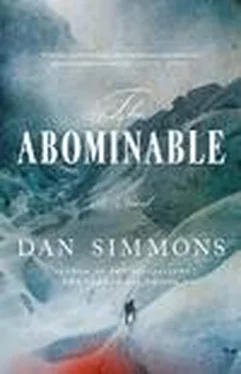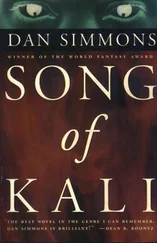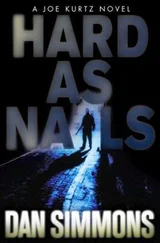“And les boches don’t need a reason to kill people,” said Jean-Claude. “It is their nature.”
I nodded as if I’d worked all that out on my own. And I would have…eventually…at least the Deacon’s part. My mind was still on the cracks, fissures, boulders, snowfields, and sheer face looming almost ten stories above me at the moment. And it didn’t like being there.
“But our using those photos…” I felt I had to say this, even if they were my last words in this life. Now I looked at all four of my companions as I spoke. “Even if it was to win a war or help preserve a peace…and all that’s just conjecture right now…using those photographs, that kind of thing, to blackmail someone…it wouldn’t…I mean, it couldn’t be… honorable. ”
Only the wind through the rocks and cliff wall spoke for a minute.
The Deacon said, “If Germans like Herr Sigl and his friends get in power, Jake, there will be another war. Count on it. And in the end, there’s nothing honorable in war. Nothing. Trust me on this one truth. The only shreds of honor that can be salvaged when war looms is either avoiding the fight completely, which men smarter than you and me suggest that these dirty, tawdry photographs might possibly do, or—when the real fight comes—behaving the best one can, even while you’re afraid every waking second, and while doing everything one can to keep one’s men alive.”
“You did that for four years, Ree-shard, ” J.C. said. “Worked to keep your men alive. You’re doing it now, here on the mountain.”
Surprisingly, shockingly, the Deacon barked a laugh. “My dear friend,” he said, touching Jean-Claude’s shoulder. “My dear friends,” he said, looking at each of us in turn. He pulled his goggles up to say this to us with his gray eyes visible, and I could see that the cold wind was already causing them to tear up. “My friends, I failed miserably at keeping men under my command alive. I couldn’t even keep our thirty Sherpas alive during this peacetime expedition. They were under my command on the mountain. Most of them are dead. Dear Jesus, I couldn’t even keep track of my own rifle, much less be smart enough to keep our Sherpa friends from being killed. If all the good men I killed or helped to be killed in the Great War were to come with us on this climb up Mount Everest, the line would extend from Darjeeling to the bloody summit.”
He fell silent.
“Well,” I said after too much of that wind and silence, “I’d better start climbing before I freeze up. This is a decent belay point, so I’ll stay roped up until I get to the top left of that snowfield about forty-five feet up. It looks like one of you could come up and belay me—or at least spot me—from that point. We’ll kick up a little platform of snow there for you if need be. But, no, it’s a shitty belay point—if I fall from that face, I’d pull the belayer right off—so let me help get one of you and the fixed ropes that high, to that snowy point right at the base of the vertical last pitch, and then I’ll free-climb it without tying on, just carrying the rope loose around me so someone else can give it a try if I peel off.”
“I’ll follow you up to that point when you find some belay points on the boulders,” said the Deacon.
Jean-Claude was leaning over the edge of the North Face, studying our footprints and route with his field glasses. “The Germans are climbing toward Mushroom Rock,” he said over the wind. “We shall have to climb quickly if we are to reach our Alamo in time.”
20.
I didn’t know a damned thing about Zen meditation, if that’s what the Deacon really had been doing when he sat cross-legged and apparently lost in thought every morning before breakfast as Reggie recently suggested, and I certainly hadn’t had the time or interest on this insane climb to ask him about it.
But I suspected then and I know now that mountain climbing—especially rock climbing under extreme, no-forgiveness-for-errors conditions—is a strange and beautiful equivalent to Zen. Everything empties out of the climber’s mind except the moves he’s planning to make, the holds he sees or senses or hopes for, the speed he’ll need to move at in order to stay attached to a steep or vertical face. One imagines—envisions, rehearses, feels— the motions he’s about to make, the stretches and reaches he’s ready to go for, the fingerholds or footholds he needs to find, the life-saving friction he’ll have to create where no friction should exist.
So, with the Deacon’s belay rope tied on for only the first half of this impossible climb, I began the scramble—first to the left toward the off-width crack corner where the faces met at a sharp angle, the all-important joint starting just below that meeting of sheer faces, a mere fracture there but widening to become the 15- or 16-foot-high off-width crack 45 feet higher up. That crack was filled with rocks and pebbles—a joint—down low and appeared from below to be no factor whatsoever in this first half of the climb.
That wasn’t quite true, actually, for as I quickly traversed left toward the south-facing wall near that joint, I moved into full shadow, and suddenly the air was painfully colder. Working near the useless joint would make me much colder—a negative factor. I had to move fast through these shaded parts, or later I’d be losing fingers, toes, feet, hands, and God knows what to the surgeon’s scalpel.
I scrambled up the narrow groove near that meeting of cliff faces, then shifted right, my fingers finding holds that my eyes couldn’t see, my crampon points balancing on cracks that were less than half an inch wide. Then a short vertical climb, my left hand jammed deeply and painfully in a vertical crack just below the cone of snow halfway up, feet scrambling to the left and then to the right before finding the faintest traction, then up again until I could balance and cough and pant on the four-inch-wide top of a tall, skinny boulder. Four inches was a boulevard up here…a Kansas prairie.
This was the “high step” up onto the snowfield I’d seen from below and had decided to worry about only when I got there.
Well, I was there. There was really nothing to wedge my crampons or hands against to get any lift for that four-foot or broader step up onto the steep, snow-covered, downward-tilting slab. (It was never level enough at any point to be called a ledge.)
Death in such rock climbing can come quickly when you pause to think things out. Sometimes you must trust to instinct, experience, and the brief advantage of adrenaline over rational thought.
Knowing now that the Deacon couldn’t hold me if I fell during this giant step— leap was more like it—and seeing 8,000 feet of empty air under my boots and between my legs as I made the upward lunge—I was, for a fraction of an instant, sorry that I’d tied onto the belay rope even for this lower, “easier” part of the climb. I really, really didn’t want to pull the Deacon with me when I slid over the edge to my death.
I landed on my belly on the slippery snow. The steep shelf had been exposed to sunlight for hours now, and parts of the snowfield were wet, slippery…my fingers clawed into loose snow and found no grip whatsoever. I began sliding on my belly backwards and to the right, toward the sheer drop-off.
Then the front-point crampons on my flailing boots found some traction in the six- to eight-inch-deep snow on this slab. My sliding slowed, then stopped. Moving in slow motion, the crampons on the front of my stiff boots the only real contact with the snow—much less the unreachable rock beneath the snow—I managed to use the four steel points at the front of my crampons to push my body inch by inch up and to my left. Eventually, despite the steep slant and the absurd exposure, I stood, reaching for a higher rock to balance myself.
Читать дальше












